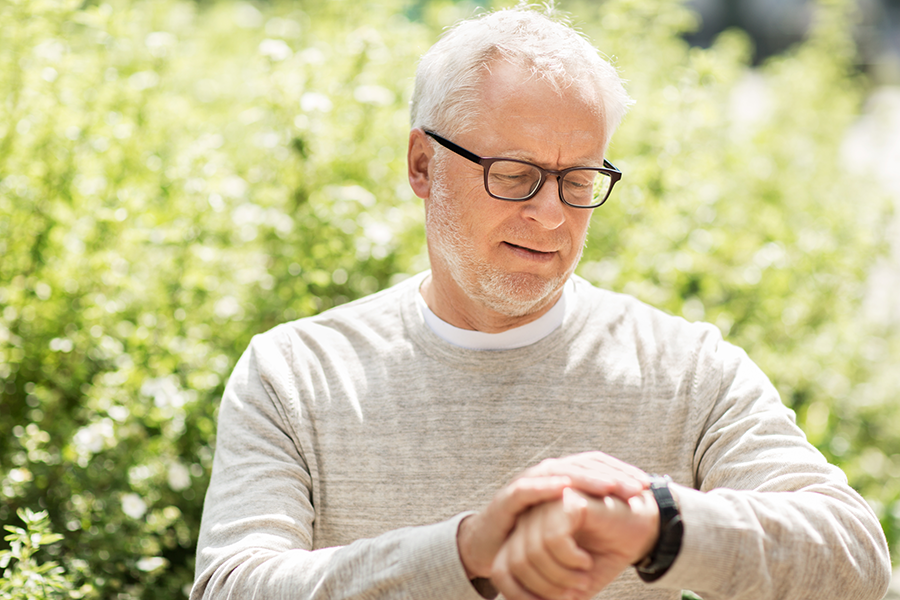

Have you avoided events and activities you enjoy because of urgent and frequent trips to the bathroom? A recent survey sponsored by Teleflex Incorporated, of 1,000 men in the United States, 45 years and older, who have experienced at least one urinary symptom associated with BPH shows that you may not be alone.
Approximately 45% of men surveyed have avoided events or activities they enjoy due to their urinary symptoms.1

Men over 45 with urinary symptoms common with an enlarged prostate, also known as benign prostatic hyperplasia (BPH), may anticipate and plan for their urgent and frequent bathroom needs. Whether they rearrange their morning schedules in anticipation of interrupted sleep, limit the amount they drink, or purposefully seek out and stay close to the bathroom, this type of extreme bathroom planning can disrupt normal daily activities.
The survey explored how urinary symptoms commonly associated with BPH impact men’s daily lives.
So how do you know if you could be an extreme bathroom planner?
If you answer “yes” to the following questions, it might be time to schedule a check-up with your doctor.
Do you avoid activities you enjoy because of your urinary symptoms?
Approximately 45% of men surveyed have avoided events or activities they enjoy due to their urinary symptoms.1
Do you map out travel routes based on the availability of restroom facilities?
More than 40% of men surveyed have chosen certain routes (roads, highways, etc.) on road trips because they have more or better availability of restroom facilities.1
Do you locate the closest bathroom as soon as you go somewhere new?
About 1 in 5 men surveyed said that locating the closest bathroom is the first thing they do when they go somewhere new.1
Do you pick event seating based on bathroom access?
About 43% of men surveyed have selected their seats when purchasing tickets to a sporting or entertainment event because it has better or easier access to the restroom.1
Do you limit the amount you drink during the day?
Nearly 62% of men surveyed have limited the amount they drink throughout the day even when they have access to a restroom to avoid a frequent or urgent need to urinate (61.86%).1
“It’s important for men to be aware of symptoms of BPH, including frequent trips to the bathroom during both the daytime and nighttime,” said Ana Fadich, vice president of the nonprofit Men’s Health Network. “While not all urinary symptoms are caused by BPH, men over the age of 45 who are experiencing urgent or frequent urinary symptoms, should consider speaking with their doctor about their prostate health.”2,3
More than 12 million men in the U.S. seek treatment for BPH.4 BPH is unrelated to, but more common than, prostate cancer,5,6 and if left untreated, it can lead to permanent bladder damage.7 The sooner BPH is treated, the sooner men can improve their symptoms and quality of life.
Medications are a very common treatment option for men diagnosed with BPH. In this survey, over 65% of men surveyed who have been diagnosed with BPH have taken a medication to treat their condition.1 Unfortunately, nearly one in four of these men said their medication was ‘not very effective’ or ‘not effective at all’ in helping them reduce their need to plan their next bathroom trip to urinate.1
But there is hope for men living with BPH.
The UroLift® System is an earlier treatment option that can help men get off BPH medications and avoid major surgery – and related complications.8,9 The UroLift System uses a proven approach to treating BPH that lifts and holds the enlarged prostate tissue out of the way, so it no longer blocks the urethra.
The UroLift System uses a proven approach to treating BPH that lifts and holds the enlarged prostate tissue out of the way, so it no longer blocks the urethra.
It is the only leading BPH treatment that does not require heating, cutting, removal, or destruction of the prostate tissue.8-13 The UroLift System can be performed as a same-day outpatient procedure in the office setting (The length of the procedure varies based on the patient’s anatomy and the number of prostatic implants required), under local anesthesia that provides symptom relief better than reported for medications7,8 and preservation of sexual function.9,15,16*
Patients typically see an improvement in their symptoms and rapid relief in as few as two weeks.8,17 Most common side effects are temporary and include pain or burning with urination, blood in the urine, pelvic pain, urgent need to urinate, and/or the inability to control the urge.8 Rare side effects, including bleeding and infection, may lead to a serious outcome and may require intervention. Speak with your doctor to determine if you may be a candidate.
To talk to a doctor about safe and effective treatments for BPH, visit the UroLift.com physician finder to find a urologist in your area.
References
1. Data on file: Men’s Health Survey 2021, n=1,000 conducted by Teleflex l NeoTract 2021.
2. Rosenberg, Int J Clin Pract 2007
3. Vuichoud, Can J Urol 2015
4. NeoTract US Market Model estimates for 2020, data on file
5. American Cancer Society Key Statistics for Prostate Cancer http://www.cancer.org/cancer/prostatecancer/detailedguide/prostate-cancer-key-statistics
6. Berry, J Urol 1984
7. Tubaro, Drugs Aging 2003
8. Roehrborn, J Urol 2013
9. AUA Guidelines 2003, 2020
10. Mirakhur, Can Assoc Rad J 2017
11. McVary, J Urol 2016
12. Gilling, Can J Urol 2020
13. Kadner, World J Urol 2020
14. Rochester, AUA 2019 presentation
15. Roehrborn, Can J Urol, 2017
16. McVary, J Sex Med 2016
17. Shore, Can J Urol 2014
*No instances of new, sustained erectile or ejaculatory dysfunction in the LIFT pivotal study
MAC02230-01 Rev A
